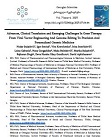Synthesis and preliminary findings of poly (Amide-co-Ester Amide)s
Downloads
Uncontrolled accumulation of synthetic materials in the environment led to ecological problems, due to their resistance to chemical or biological degradation. One strategy to augment the biodegradability of convenient polymers involves introducing more hydrolysable groups into their structure. Exceptionally important representatives of biodegradable polymers are pseudo-proteins - a new family of synthetic biodegradable polymers based on natural α-amino acids. One of the members of pseudo - proteins class of polymer include poly(ester amide)s , which are characterized by easily synthesis and versatile application. During the research Poly (Amide-co-Ester Amide)s were synthesized via interfacial polycondensation reaction mechanism, between monomers: Hexamethylenediamine (HDMA) and Tosyl diamine diesters (TDADE) with various diacid chlorides. Solubility of obtained products was studied in various solvents. Structures were checked by FTIR and NMR spectroscopy methods. Mechanical properties were evaluated using Tensile Testing Machine.
Downloads
Vroman, I., & Tighzert, L. (2009). Biodegradable polymers. Materials (Basel), 2 (2), 307–344.
Sardon, H., & Dove, A. P. (2018). Plastics recycling with a difference. Science, 360 (6387), 380–381. https://doi.org/10.1126/science.aat4997
Duan, H., Song, G., Qu, S., Dong, X., & Xu, M. (2019). Post-consumer packaging waste from express delivery in China. Resources, Conservation and Recycling, 144 , 137–143.
Khatoon, N., Jamal, A., & Ali, M. I. (2019). Lignin peroxidase isoenzyme: A novel approach to biodegrade the toxic synthetic polymer waste. Environmental Technology , 40 (11), 1366–1375.
Chandra, R., & Rustgi, R. (1998). Biodegradable polymers. Progress in Polymer Science , 23 , 1273–1335. https://doi.org/10.1016/S0079-6700(97)00039-7
Tokiwa, Y., Calabia, B. P., Ugwu, C. U., & Aiba, S. (2009). Biodegradability of plastics. International Journal of Molecular Sciences , 10 (9), 3722–3742. https://doi.org/10.3390/ijms10093722
Rodríguez-Galán, A., Franco, L., & Puiggalí, J. (2011). Biodegradable poly(ester amide)s: Synthesis and applications. In G. P. Felton (Ed.), Biodegradable Polymers: Processing, Degradation, Applications (Chapter 4). Nova Science Publishers, Inc.
Díaz, A., Katsarava, R., & Puiggalí, J. (2014). Synthesis, properties, and applications of biodegradable polymers derived from diols and dicarboxylic acids: From polyesters to poly(ester amide)s. International Journal of Molecular Sciences , 15 (5), 7064–7123. https://doi.org/10.3390/ijms15057064
Zavradashvili, N., Puiggalí, J., & Katsarava, R. (2020). Artificial polymers made of α-amino acids - Poly(amino acid)s, pseudo-poly(amino acid)s, poly(depsipeptide)s, and pseudo-proteins. Current Pharmaceutical Design , 26 . https://doi.org/10.2174/1381612826666200203122110
Copyright (c) 2024 Georgian Scientists

This work is licensed under a Creative Commons Attribution-NonCommercial-NoDerivatives 4.0 International License.








































































































































































































